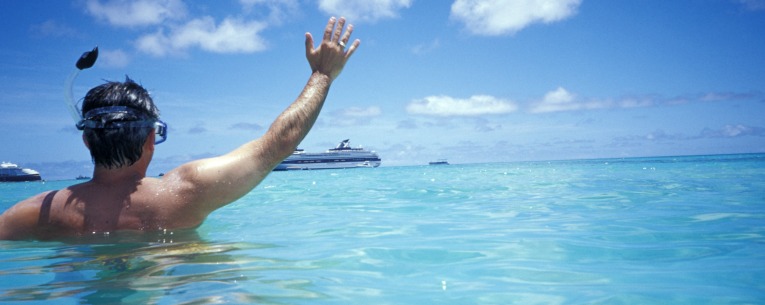Parasailing, snorkeling, sightseeing: Cruise excursions are where your best vacation memories are made — or your worst. Accidents can and do happen on cruise excursions, and just because an activity is sponsored by the cruise line doesn't mean it's risk-free.
But who wants to spend their entire cruise vacation on board the ship? It's possible to enjoy cruise excursions while staying safe. Here's a look at some real-life cruise excursion nightmares and what you can do to prevent one of your own.
Accidents on Cruise Excursions
Here are three examples of some real-life, recent cruise excursion nightmares.
1. A couple who were passengers on a Royal Caribbean cruise went on a cruise excursion in Bermuda that involved bell diving: going underwater in an air-filled helmet. According to a lawsuit filed by the woman's husband, the couple's helmets partially filled with water while they were diving, and the woman began to asphyxiate. They brought her to the surface and gave her oxygen; but, the suit says, the tank was empty and the woman died. The suit against the excursion operator and Royal Caribbean was dismissed.1
2. In 2012, a mother and daughter who were passengers on a Celebrity Cruise went on a parasailing cruise excursion in St. Thomas. While parasailing, the rope broke and both women plummeted to the water. The mother died, and her daughter suffered serious injuries. The woman's family filed suit against Celebrity and the excursion operator.2
3. In 2010, a Carnival passenger participated in the Cozumel Beach Party excursion at Señor Frog's in Cozumel, Mexico. The excursion, according to a lawsuit filed by the passenger, was advertised as having a water slide directly into the ocean and unlimited drinks for three and a half hours.3 The passenger dove off the seawall around Señor Frog's and struck his head on the shallow bottom. He became a paraplegic.4
Other cruise passengers have collided with a tree during a Jamaican zip-line excursion, been struck by lightning during a catamaran ride in Montego Bay, and been injured while riding an ATV in Acapulco, Mexico.5
How to Protect Your Safety on Cruise Excursions
There are three essential questions to ask before participating in cruise excursions, according to the Hon. Thomas A. Dickerson, a New York Associate Justice who has been writing about travel law for 38 years:
1. Is the local excursion operator insured (or underinsured), licensed and trained?
2. Has the cruise line evaluated the reliability of the local operator?
3.Has the cruise line disclaimed liability for any injuries passengers might sustain during excursions?
The question of whether a cruise line is liable for accidents during ship-sponsored cruise excursions has been debated many times in court. Attorneys have argued that cruise lines have a duty to warn passengers about potential dangers and that cruise lines have been negligent in selecting their ground operators. Cruise lines have argued that they're not responsible for the actions of independent excursion companies.6
Prudent travelers may opt out of cruise excursions that are inherently risky, such as parasailing or cave tubing. But even something as innocuous as a bus tour may prove dangerous: while on a tour of Mazatlan, Mexico, a Holland America Line passenger fell into a sinkhole when the pavement collapsed.7 In short, take responsibility for your own safety while on cruise excursions. Don't assume an offered program is safe, and don't mix alcohol with swimming, diving or other physical activities.
Crime and Cruise Excursions
Cruise passengers are often targeted by thieves because they're likely to carry cash and valuables. To avoid becoming the victim of crime while on cruise excursions, stay aware of your surroundings and don't rely blindly on the tour guide. Travel in groups and don't display items that identify you as a cruise ship passenger, such as your onboard ID or items branded with the ship's name. Walk with purpose instead of wandering, and avoid public intoxication.8
Be especially vigilant when traveling to cruise ports known for high crime. One of these is the Bahamas. In November 2014, the U.S. Department of State's Bureau of Diplomatic Security recommended American citizens be on heightened alert while visiting the Bahamas because of increased and more brazen crimes. Three armed robberies of U.S citizens have taken place during daylight in touristy areas, the bureau reports.9 Sexual assaults, too, are a danger: since July, the bureau says, there have been three reported sexual assaults on U.S. citizens, including minors, by jet ski operators on Paradise Island.10
Honduras is another destination where caution is advised. Since 2010, Honduras has had the highest murder rate in the world.11 While cruise destinations like Roatan and Bay islands have a lower crime rate than other parts of the country, the State Department reports that the rate of thefts, break-ins, assaults, and murders is still high.12
How Cruise Travel Insurance Can Help
Before you leave for your cruise, make sure you're protected with cruise insurance. Travel insurance with emergency medical benefits can reimburse you for medical expenses incurred due to a covered illness or injury. Emergency medical transportation benefits can provide needed transportation to the nearest appropriate medical facility. Keep in mind, however, that travel insurance typically won't cover injuries that result from abusing alcohol or drugs, or from extreme sports.
Remember that the travel experts on Allianz Global Assistance's 24-hour hotline are always there to offer guidance and advice. If you're the victim of a crime, they can help you report it to authorities and replace stolen documents. If you're sick or injured, they can advise you on where to go to seek the best care or help you arrange transportation home. With Allianz travel insurance, you never cruise alone.








Share this Page